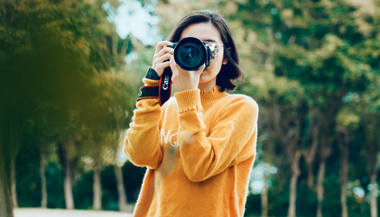If there's one thing photographers of all experience levels agree upon, photography can be tough sometimes. Luckily, the most common photo fails are getting easier to fix as technology improves. Here are 8 of the most common issues with digital images and the easy changes you can make to fix each one:
1. The finished photo is too dark.
A dark photo is usually the result of photographing with an ISO that is too low. ISO is a measure of how sensitive your camera is to light. So, in a low-light setting, keep your ISO higher to capture as much detail as possible.
2. The angle from which you’re photographing is too low.
Everyone who’s used the “face time” feature on their phone or computer knows that most images taken from below eye level are somewhat unflattering.
Keep the lens above the subjects’ faces to help them look their best in the final images.
3. Your subjects are different distances away from you.
“Depth of field” is a photography concept that describes the distance between the nearest and furthest objects from the lens.
If you’re photographing two things that should be in sharp focus, position them along the same plane when the photograph is taken or use a smaller aperture (such as f11, f16, or f22).
If you’re taking a photo of a two people together, both of their noses should be pressing up against the same, invisible pane of glass. That will ensure that their facial features can be captured in the same amount of detail.
4. Your shutter speed is too slow to capture fast motion.
Whether you’re photographing a squirmy pet, your child’s soccer game, or a Graphic Designer jumping up in the air (see below), quick motions can cause photographs taken with a slow shutter speed to be blurry.
If possible, use a shutter speed of 1/1000+ when photographing sports or other motion-heavy activities.
5. Too little or too much contrast.
If you find that the spectrum of light that you see with your naked eye is greater than the detail captured in the photo, it’s most likely due to a lack of contrast.
Fixing the contrast in your photo is easier than it’s ever been before. Most smartphone camera applications have easy ways to expose photos correctly, as do desktop programs like Lightroom.
If your photo is still too bright and lacking in definition, try covering the top of the lens with a jacket or a blanket to reduce the sunlight that reaches the lens.
6. Your horizon is crooked.
Even if you feel like you’re standing on even ground, it’s easy to accidentally take a photograph in which the horizon isn’t perfectly straight.
Rotate the photo in your photo editing program to make sure the image is exactly how nature intended. You’d be surprised how big of an improvement this makes in the final composition!
7. The neutral tones in the image have a yellow tint to them.
White balance determines how a camera will interpret every color that’s in front of the lens. White balance settings can be adjusted in-camera based on changing color conditions.
8. Your photo looks pixelated.
All photos are made of pixels, or tiny squares of color. When a digital image file or printed photo has too few of them, the photo looks less realistic. The more pixels a photo has, the higher its resolution.
Higher resolution photos look sharp, clear, and true-to-life. Resolution is reduced, however, when you use a digital zoom feature or when you crop a photo. Check out our Image Resolution Guidelines to learn more.
What are some of your tried-and-true fixes for these common photo fails? Post them below in the comments!








